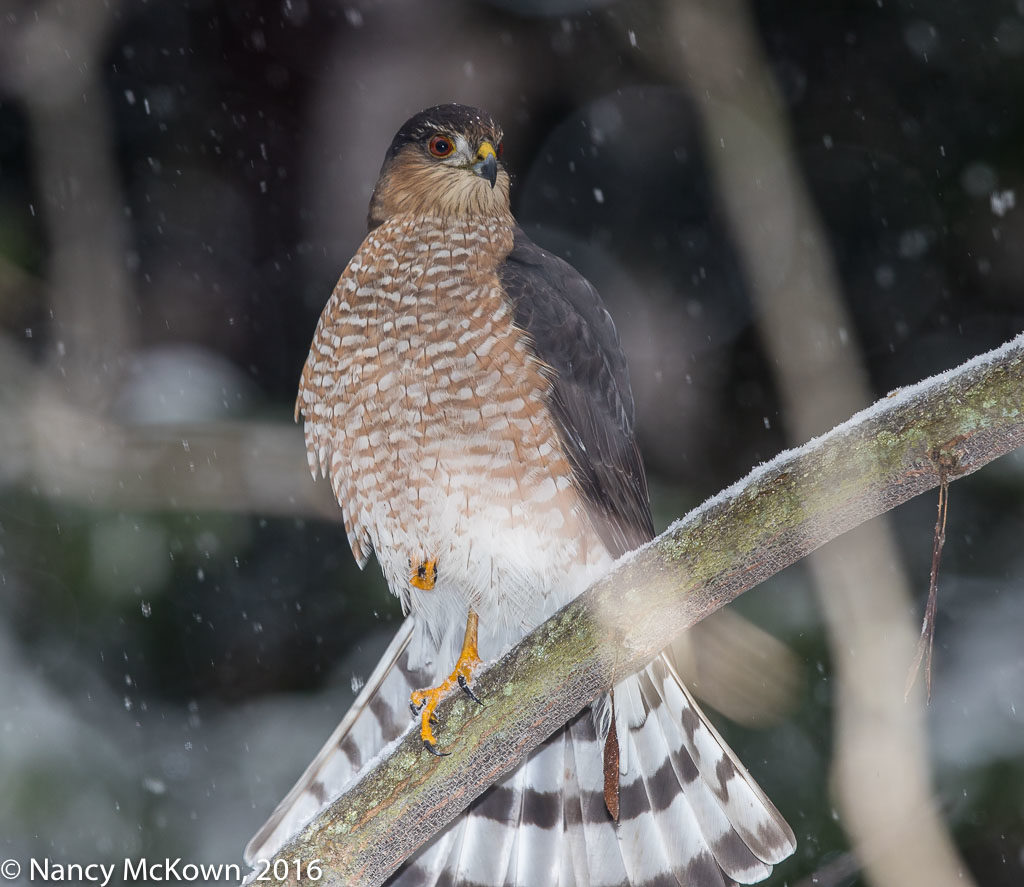Photographing a Sharp Shinned Hawk
Baby it’s cold outside.
I’ve been inside the house with my camera, watching the year-round birds at the feeders and looking for behaviors that might indicate that a hawk was lurking nearby. These include eerie silence, no activity, and perhaps one or two Downy Woodpeckers clinging to a branch, still as death.
I spotted a Sharp Shinned Hawk obscured in the foliage of one of the tall arborvitaes (Northern White Cedar) on the property line. This perch was distant and too heavily obstructed for the lens to focus accurately. I only saw the concealed bird because another Sharpie rousted him from his hiding place. After a fast paced and aggressive chase, the dominant raptor finally managed to force the interloper out of her hunting territory .

Look at that fierce face and towering demeanor!
Makes you glad you’re not a small mammal or songbird.
Notice the Seed Pod from a Red Bud
Tree Entangled in Her Splayed Tail Feathers.
ISO400; f/8; 1/250 Second
Prepping for a Possible Encounter
Once I spotted the hawks, I opened a couple windows in the library (despite the wind, snow and intense cold), and maneuvered my rig into place. The scene was heavily clouded, so I attached the flash, hoping the fill light would enhance the color and sharpness of the images. After 30 bone chilling minutes, the Sharpie did fly in and perch on a nearby branch.
A Little Too Close
The perch upon which the Sharpie alighted was slightly above camera level, but too close for the 500mm lens to include all of the bird and leave a pleasant frame. Notice that in both images, the bottom parts of the splayed tail feathers are cut off.
During camera setup (when I am not rushed), I always try to position the lens so as to optimally frame whatever bird I hope to photograph that day. The goal is to visually balance the setting to include some context for the viewer.
I missed the mark. This was a large Sharpie (female raptors tend to be approximately 25% larger than males) and she was just too close to the lens to include a pleasant border.
Possible Remedies
There are strategies that I could have used to remedy the situation.
- Reorient the tripod collar to a vertical position. I did not do that because the tele flash on bracket and battery pack were attached (and necessary – ISO reading at 8000), so turning the tripod collar to a vertical position would have thrown off the trajectory of the light beam and possibly upset the weight balance of the gear.
- Move the whole tripod setup farther back into the library. Re-situating a large, heavily laden tripod only takes a minute to do, but it does cause a distraction. Birds don’t wait around for you, so I attempt that move only after I get in the first few shots. I was glad I did not take the time to move the gear because the Sharpie perched less than a minute.
(NOTE: I love the quality and precision of prime lenses, but for situations like this I wish I had a quality zoom lens. Canon makes a 200-400 F/4L zoom lens with a built-in 1.4x extender, giving the lens a range of 280-560mm (f/5.6) on my full frame DSLR. This means optimal versatility when out in the field photographing birds, especially in situations where it is difficult or unwise to move the camera or attach or detach an extender. (NOTE: One day I plan to rent this lens. It is ridiculously expensive to purchase…$10,999!)
Photographing Birds in Falling Snow
Snow flakes can float down gently or fall fast and furious. To capture them, you need to decide what look you want and adjust the exposure settings appropriately. The slower the shutter and the faster the snowfall, the more fog-like blurring and streaking you will see.

Taken with tele flash
ISO400; f/8; 1/250 Second
During this shoot, the snow looked picturesque (big, soft, feathery ice crystals) and fell fast. I kept the telephoto flash on bracket turned on because heavy cloud cover darkened the scene and I needed some fill light to reach my preferred aperture and ISO. The shutter speed was set to the camera’s flash maximum sync speed of 1/250 second. The flash did a good job of illuminating the scene but flash will not freeze motion if there significant ambient light on the scene. In addition, the notoriously shallow depth of field on the 500mm lens was blurring the snowflakes in front of and behind the Sharpie.
End result: The camera captured a few snow flakes that look like round unattractive blotches. The flash illuminated the large snow flakes in the foreground, causing those splotches to stand out the most.
On-The-Job Training and Hindsight
Take-away from this shoot: Lots to things prepare for when photographing birds in the snow. I’m hoping that all this on-the-job training and hindsight will eventually translate into better bird photography.
(NOTE: Flash has been an essential tool to photograph birds this winter. Per our local weatherman’s blog (Bill Steffen), “….between Dec 1-18, 2016, SW Michigan had only 2 hours and 41 minutes of sunshine, or 8.9 minutes per day…. Jan 15 was only the 4th day since Nov. 29th with more than 45% of possible sunshine. Twenty-six of the last forty-five days have had zero sunshine…not even a minute.”)









fierce indeed!